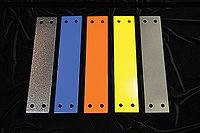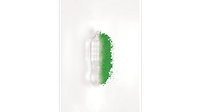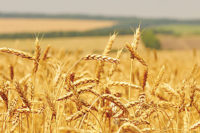Post-Addable Powder Coating Additive Technology

Over the years, the powder coating industry has evolved in many ways. There are a whole host of examples. Most notably the processing/application equipment used today is much more effective and efficient versus earlier years. In addition, the breadth of substrates being utilized around the globe has evolved to include many nonferrous surfaces along with a series of advances and innovations in the design and development of new raw materials. This holistic approach by a broad array of stakeholders has fostered continuous improvement in the industry.
From an additives perspective, most of the conventional products used in the powder coating industry today are incorporated into the middle of the premix, thoroughly homogenized, transferred into an extruder, pulverized and converted into a micronized powder with a distinct particle size distribution.
However, there are many instances where it may be advantageous to solve performance and/or application deficiencies by adding materials to a finished product after the powder coating has been completely packaged and placed in inventory. When raw materials are incorporated into a finished powder they are referred to as “post-addable technology.” This article will focus on post-addable matting and texturing additives.
Hypothetically speaking, let’s say your customer urgently needs 100 lbs. of a textured polyester TGIC based on any of the popular colors highlighted on a powder manufacturer’s color card. Unfortunately, there is only a high-gloss product available in the inventory pipeline. If you were faced with this scenario what would you do? More than likely the salesperson would tell the customer they could provide a product like this in a specified period of time. In-turn, the technical and operations’ team would be obligated to produce the 100 lbs. of powder.
Undoubtedly, this unmet need will take a notable amount of time and resources to fulfill. The lab will have to wait on the standard (if available), create a technical service request, develop a completely new product, enter/upload the applicable paperwork, and then hand-off the formulation to production. The operations’ team will then have to create a batch ticket, complete a very thorough cleaning process on the mixing/production equipment, manufacture the small order, and complete another thorough cleaning process on the mixing/production equipment so there is a minimal impact on the downstream production campaign.
Without question, each of these steps take time, and you certainly don’t want your customer calling a competitive powder coating manufacturer to see if they can speed up the delivery process.
Alternatively, if you had the option of quickly converting a specific high-gloss smooth powder coating from current inventory into a product that has a matte or textured finish it would certainly be much easier and efficient. The operations’ team would only have to procure the correct product from the inventory database, transport that material to the production site, cut a batch ticket, clean the mixing equipment, add the post-addable technology to the finished powder coating, re-blend, re-package, and ship the new matte or textured product to the customer.
Conceivably, this type of easy-to-use technology would rapidly generate an exponential number of saleable products for the powder coating applicator based on a powder manufacturer’s fixed number of stock products highlighted on a color card. This scenario would be a win-win situation for both companies.
Economically speaking, these post-addable additives were developed for smaller orders (e.g. ≤ 500 lbs.). Otherwise, if the powder manufacturer chooses to use conventional lab and production processes for manufacturing a new product, the fiscal impact is arguably much higher because the conversion costs are magnified when producing small orders.
There are also several advantages when modifying existing products from current inventory versus developing a completely new SKU. First of all, on an annualized basis, a powder manufacturer has a greater monetary impact on their organization based on the number of pounds they produce. Secondly, limiting the inventory holding costs is always beneficial to the bottom line.
If a production team must incorporate a new formulation for a small order into the manufacturing schedule that could quickly be fulfilled utilizing existing inventory, an easy-to-use post-addable additive and a blending process that is in a separate part of the plant, this would clearly be advantageous.
Furthermore, the number of steps would be reduced, and the labor and overhead would be significantly lower. The fixed costs, set-up costs, equipment cleaning costs, and the cost of interrupting a highly efficient production campaign would undoubtedly be favorable to any powder manufacturer’s bottom line.
To expound further, this article will highlight many of the developmental considerations related to creating an effective post-addable platform, the incorporation techniques and some results from numerous laboratory experiments. There is also information on where these products may fit into the powder coating marketplace.
Developing a Post-Addable Additive
The criteria for developing a successful post-addable additive includes the following:
- An extrusion process is not required to get the product to perform as intended.
- Micronized product that is 100% active and specific in function.
- Product that is easy to incorporate.
- Technology that doesn’t affect the mechanical properties of the control.
- Additive that doesn’t deteriorate exterior durability.
- No negative effects on recoatability.
- Functional in all the standard powder coating chemistries.
- No impact on standard cure cycles.
- Appropriate specific gravity and particle size distribution.
- Technology with no impact on application properties.
- No contamination problems with the application equipment.
- Broad regulatory compliance.
The post-addable products that are highlighted in this article will deliver a matte or textured appearance to existing smooth gloss or semigloss inventory. They are designed for easy incorporation through conventional blending techniques such as high-speed mixing, ribbon blenders and fluidized beds. This offers powder coating manufacturers the speed and flexibility to fill small or special orders, particularly when a stock color can be easily transformed. These additives can also be used to correct off-spec powder coating batches made with insufficient gloss or texture. Fundamentally, this technology alters an existing product from a smooth, glossy appearance to a matted or textured coating without the need for extrusion.
Standard Techniques for Matting Powder Coatings
Specular gloss can be controlled by both physical and chemical means. Powder coatings with 60° gloss ≥ 35 are generally produced by incorporating select wax additives and fillers in the premix and then extruded. Matting hardeners are often used to matte polyester/epoxy hybrids. Gloss can also be controlled to some extent with large-particle-size inorganic fillers.
Polyester systems designed for outdoor applications can be matted by using a dry-blend method. Two powder coatings with different ratios of curing agents are manufactured and dry-blended using conventional mixing equipment. A matting effect is produced by competing reactions yielding an incompatible formulation. This method is labor intensive and time consuming. Two powder coatings must be manufactured and subsequently blended to achieve the desired gloss.
Post-Addable Matting
PowderAdd™ 9553 is a novel, post-addable matting agent that consistently provides reproducible and uniform matting. This easy-to-use additive is highly efficient and quickly turns glossy powders into matted technology, reducing production costs and inventory requirements for small batch manufacture. It works with all standard powder chemistries. It is as easy as taking packaged material off the shelf, post-adding the additive, re-blending the mixture using conventional mixing equipment and repackaging the material for commercial sale. Alternatively, the additive can be added directly to the finished powder coating in a fluidized bed before spraying the material.
Multiple trials have shown that the gloss can be decreased to 25-70% of the original gloss, depending on the initial gloss and the addition level of PowderAdd 9553. The cure cycle of the original powder coating can be maintained.
Features and Benefits
PowderAdd 9553 provides the following benefits:
- Converts a smooth, high/semigloss powder coating finish into a matte finish.
- Creates a uniform color and gloss that is highly reproducible.
- Effective in all standard powder coating chemistries.
- Corrects off-spec batches that do not meet gloss targets when evaluating a sample in QC.
- Can save powder coating manufacturers time and money.
- Simplifies inventory management, enabling small-batch matted powder coatings.
- Provides a uniform, aggressive matting effect.
Figures 1 and 2 show performance results of this new matting additive.

FIGURE 1 » Performance data for the new post-addable matting additive.

FIGURE 2 » Photos showing the change from a glossy to a matte surface with the use of the post-addable additive.
Standard Techniques for Texturing Powder Coatings
Most powder coating texturing agents are added to the premix prior to the extrusion process. Textured formulations can be achieved by either physical or chemical techniques.
Physical modifications are routinely achieved by manipulating the types of processing equipment and/or adjusting the manufacturing settings. As a result, the particle size distribution of the finished powder can be modified to achieve a very specific textured appearance. In addition, there are a variety of products in the marketplace that do not melt or have a unique softening point, and the appearance of the texture will be determined by the physical properties and particle size distribution of these materials. Chemical transformations to a powder coating appearance are routinely based on components that are subtle contaminants or slightly incompatible materials to the resin chemistry.
Textures that appear to have a 60° gloss > 30 are generally called “wet-look” textures. This appearance is achieved by incorporating select wax additives and fillers into the premix and then extruded.
A textured appearance and gloss can also be controlled to a certain extent with inorganic fillers that have variances in particle size and oil absorption.
Finished powder coatings with measurably different particle size distributions can be blended for unique texturing effects. This method is labor intensive and more time consuming.
Post-Addable Texturizing
PowderAdd 9566 is a novel post-addable texturing additive that is intended to convert a smooth powder coating finish into a fine/medium texture. This technology will not create a river, hammertone, wrinkle or leatherette appearance.
The post addition of this product gives the powder coatings manufacturer the ability to quickly turn ready-made powder coatings into textured finishes. It is as easy as taking packaged material from the shelf, post-adding PowderAdd 9566 into the finished product, re-blending and re-packaging the material for commercial sale.
Due to the fine texturing effect, the initial gloss is expected to be significantly reduced. However, the standard cure cycle of the original powder coating is maintained
Features and Benefits
PowderAdd 9566 provides the following features and benefits.
- Converts a smooth powder coating formulation into a textured appearance.
- Easy to incorporate by hand or with conventional mixing equipment.
- Creates a uniform texture, color and gloss.
- Effective in all standard powder coating chemistries.
- Saves powder coating manufacturers time – less downtime in production for cleaning.
- Recovers batches that don’t produce a texture.
- Can save off-spec textures or convert batches with appearance defects to a textured finish; for example, craters, pinholes, fish-eyes.
- Can be used to mask unusually poor substrates where a smooth finish wouldn’t work.
- Simplifies inventory management.
- Will not contaminate application equipment for subsequent jobs at the coater. Normal cleaning procedures are required.
Because there may be some variation in film thickness, which often occurs at the job site, the manufacturer must use adequate pigmentation levels to ensure the desired degree of hiding. To achieve the appropriate texture, the film thickness required may be higher than that of the original smooth coating. Conceivably, the targeted film thickness for the texture may be in the range of 75-100 microns (~ 3-4 mils).
Figures 3 and 4 show performance results of this new post-addable texturing additive.

FIGURE 3 » Performance data for the new post-addable texturizing additive.

FIGURE 4 » Photos showing the texturizing effect produced with the new additive.
Summary
PowderAdd 9553 and PowderAdd 9566 can be effectively utilized as post-addible solutions to alter smooth or glossy stocked powder coatings into matted or textured finishes while circumventing the high research and development, and production costs normally associated with small, quick turnaround orders and reducing manufacturing complexities. As a result, this will save powder coating manufacturers a notable amount of time and money.
Acknowledgments
Heiko Dietrich, Synthesis Scientist and Ralf Eberhards, Global Technology & Applications Manager at Lubrizol Deutschland GmbH in Ritterhude, Germany.
Looking for a reprint of this article?
From high-res PDFs to custom plaques, order your copy today!









